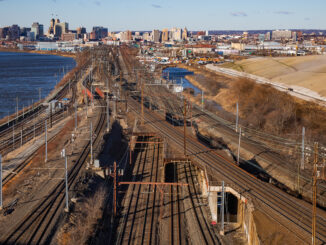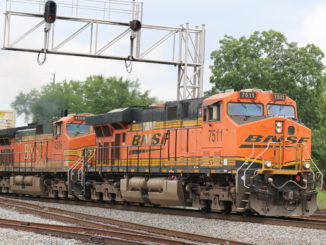PHILADELPHIA — Amtrak’s next generation of locomotives are undergoing “rigorous” testing before they enter regular service next fall.
A pair of the Amtrak Cities Sprinter (ACS-64) electric locomotives are being put through the paces at the Transportation Technology Center (TTC) facility in Pueblo, Colo., while a third locomotive will run field tests on the Northeast and Keystone corridors this summer. A fourth will be tested in a climate-controlled chamber to see how it reacts to the extreme temperatures — both hot and cold — it might see while in service.
The new ACS-64 locomotives, built by Siemens Mobility, will replace Amtrak’s fleet of AEM-7 (known as “meatballs” by some railfans) and HHP-8 electric locomotives. The new engines will pull regional and long-distance trains along the Northeast and Keystone corridors.
“These locomotives are the new workhorses of the Amtrak fleet in the Northeast and they must meet our performance-based specifications and reliability needs so we can keep the region’s people and economy moving,” Amtrak President and CEO Joe Boardman said in a recent statement.
Amtrak says the new locomotives will be easier to maintain and use less energy than it’s current fleet. Additionally, the locomotives’ “regenerative braking system” will feed energy back into the power grid, according to Amtrak.
Amtrak placed the $466 million order for 70 of the locomotives in October 2010. While Amtrak will start using the first of the locomotives this fall, complete delivery of the new engines will take until 2016.
The locomotives, which can travel speed of up to 125 mph on the Northeast Corridor, will be built in a Siemens plant in Sacramento, Calif. Parts for the locomotives are being manufactured in facilities in Norwood, Ohio, Alpharetta, Ga., and Richland, Miss., according to Amtrak.
According to the New York Observer, the locomotives will be slower and more expensive to maintain than comparable off-the-shelf models. That’s because of the regulations demanded by federal authorities, according to the report.
The new locomotives are just one upgrade Amtrak wants to make to the Northeast Corridor.
Amtrak wants to upgrade its operations along the Northeast Corridor and bring about a true high-speed rail. But, the railroad made it clear public money will be needed to fund upgrades to the 457-mile-long corridor, which could cost taxpayers upwards of $151 billion and take as long as 30 years to complete.





